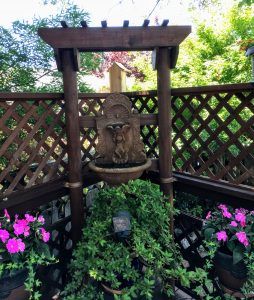Create a Moon Garden for Night-time Magic
Most of us design our gardens and make our plant choices with daytime in mind. In one sense, though, it’s ironic that we spend so much money and effort on the daylight garden, when the only time we have to unwind and relax outside in spring and summer is at dusk or after dark. So, why not create a garden that comes alive after nightfall? Often called a “moon garden,” it features flowers and foliage that sparkle at night and are typically more fragrant then.
A good place to start is to select plants that mirror their twinkling counterparts in the night sky, with white flowers and/or silver foliage. Astilbe is a beautiful, low-growing woodland plant with fern-like foliage and clusters of showy flowers, available in white. Lily of the Valley (Convallaria majalis) is a North American woodland native that has sword-shaped, upright leaves and tiny, bell-like white flowers that hang down from thin stalks. The scent is pure perfume. This shade lover can spread aggressively though, so you might need to keep it in check. Other good choices include white peonies, roses, jasmine, groundcover sweet alyssum, and of course, for the brave at heart, gardenias. Then there are star-bright foliage plants like the near-white and variegated hostas, silver artemesias, and variegated ribbon grass (Phalaris).
A moon garden is the perfect place for plants whose flowers open only after dusk, or that only unfold and release their heady fragrances when the moon is full. The lovely moon flower vine (Ipomea alba) is one of those, and is a double delight in the evening garden; its large, white flowers practically glow in the dark, and its scent is subtle, but delicious. Night-blooming jasmine (Cestrum nocturnum), which is not actually a true jasmine, has an intense fragrance. Site it carefully, though, as the white berries that form after flowering are pretty, but quite toxic. “Casa Blanca” oriental lily has big, beautiful, pure white blooms with red stamens and a sweet fragrance. The exotic and fragrant angel’s trumpet or datura (Brugmansia) is a vining plant with large, pale yellow, fragrant flowers that hang down amidst heart-shaped leaves. Take care with this one, though, because all parts of the plant are poisonous. If your garden tastes run more toward desert natives, the large class of Cereus cactus includes some night-blooming varieties, and one, Selenicereus grandiflorus, that blooms only one night a year.
It may seem a little mysterious, these plants that only bloom or release their fragrances at night, but there’s actually no mystery. They have evolved to be most attractive to nocturnal pollinators like certain moths and bats. And so, after drawing in their night-time visitors, many of these night-blooming wonders close their petals come dawn.
After a long, hot day, when the air cools at dusk and we finally have a few precious hours to unplug and notice Mother Nature, there is nothing like a garden that enchants at night. The sights and smells can be magical, and best of all, it’s a wholly different natural “world” to enjoy.
Rachel Oppedahl is a University of California Cooperative Extension Master Gardener of Tuolumne County.
UCCE Master Gardeners of Tuolumne and Calaveras Counties can answer home gardening questions. Call 209-533-5912 or go to: http://ucanr.edu/survey/survey.cfm?surveynumber=7269 to fill out our easy-to-use problem questionnaire. Check out our website at: http://cecentralsierra.ucanr.edu/Master_Gardeners/ You can also find us on Facebook.

